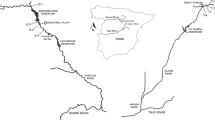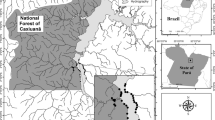Abstract
We investigated morphological response of yellow water-lily and arrowhead to water velocity gradient in the lowland Wełna river (Western Poland). Percentage cover of floating and submerged forms of yellow water-lily and arrowhead had been measured in randomly selected sites of 16 m2. We analyzed 62 stands of Nuphar lutea and 80 stands of Sagittaria sagittifolia using 13 environmental variables. Redundancy analysis (RDA), the Monte Carlo permutation test, ranges of chemical and hydrological data, Generalized Additive Models (GAMs) and transfer function were used to describe reaction of investigated species to water velocity. Among the analyzed parameters of microhabitats with the floating and submerged forms of investigated species, velocity, pH, water colour, hydration and organic matter in bottom sediments were statistically significant. In S. sagittifolia case, the velocity was the most important parameter, while in N. lutea — both velocity and content of organic matter in river substrate were statistically significant.
Similar content being viewed by others
References
Carr G. M., Duthie H. C. & Taylor W. D. 1997. Models of aquatic plant productivity: A review of the factors that influence growth. Aquat. Bot. 59: 195–215.
Casper S.J. & Krausch H.D. 1980. Pteridophyta und Anthophyta, 1. Teil. In: Ettl H., Gerloff J. & Heynig H., (eds), Süßwasserflora von Mitteleuropa, Band 23. Gustav Fischer Verlag, Stuttgart, 403 pp.
Chambers P. A., Prepas E. E., Hamilton H. R. & Bothwell M. L. 1991. Current velocity and its effect on aquatic macrophytes in flowing waters. Ecol. Appl. 1: 249–257.
Clescerl L.S., Greenberg A.E. & Eaton A.D. (eds), 1998. Standard methods for the examination of water and wastewater. American public health association, Washington D.C., 1325 pp.
Dijkstra J. T. & Uittenbogaard R. E. 2010. Modeling the interaction between flow and highly flexible aquatic vegetation. Water Resour. Res. 46: W12547 DOI 0.1029/2010WR009246
Dijkstra J.T. 2012. Macrophytes in estuarine gradients: flow through flexible vegetation. Ph. D. dissertation, Delft University of Technology, Delft.
DiTomaso J. M. & Healy E.A. 2003. Aquatic and riparian weeds of the West. University of California, Division of Agriculture and Natural Resources, Oakland, 442 pp.
Fér T. & Hroudova Z. 2008. Detecting dispersal of Nuphar lutea in river corridors using microsatellite markers. Freshw. Biol. 53: 1409–1422.
Ferreiro N., Giorgi A. & Feijoó C. 2013. Effects of macrophyte architecture and leaf shape complexity on structural parameters of the epiphytic algal community in a Pampean stream. Aquat. Ecol. 47: 389–401.
Green J. C. 2006. Effect of macrophyte spatial variability on channel resistance. Adv. Water Resour. 29: 426–438.
Grime J.P 1979. Plant strategies and vegetation processes. John Wiley, Chichester, 220 pp.
Grīnberga L. 2011. Macrophyte species composition in streams of Latvia under different flow and substrate conditions. Est. J. Ecol. 60: 194–208.
Gurnell A.M. 2013. Plants as river system engineers. Earth Surf. Process. Landf. 39: 4–25.
Gurnell A.M., O’Hare J.M., O’Hare M.T., Dunbar M.J. & Scarlett P.M. 2010. An exploration of associations between assemblages of aquatic plant morphotypes and channel geomorphological properties within British rivers. Geomorphology 116: 135–144.
Gutknecht D. & Stephan U. 2002. Hydraulic resistance of submerged flexible vegetation. J. Hydrol. 269: 27–43.
Hastie T. & Tibshirani R. 1990. Generalized additive models. Chapman and Hall, London, New York, 352 pp.
Horppila J. & Nurminen L. 2003. Effects of submerged macrophytes on sediment resuspension and internal phosphorus loading in Lake Hiidenvesi (southern Finland). Water Res. 37: 4468–4474.
Hroudová Z. 1980. Ecological study of the species Sagittaria sagittifolia L., Butomus umbellatus L., Bolboschoenus maritimus (L.) Palla and Oenanthe aquatica (L.) Poir. PhD. Dissertation, Institute of Botany, Pruhonice.
Juggins S. 2003. C2 Software for ecological and palaeoecological data analysis and visualisation. User Guide Version 1.3. University of Newcastle, Newcastle upon Tyne, 69 pp.
Klančnik K., Pančić M. & Gaberščik A. 2013. Leaf optical properties in amphibious plant species are affected by multiple leaf traits. Hydrobiol. http://link.springer.com/10.1007/s10750-013-1646-y (accessed 02.12.2013)
Kleeberg A., Köhler J., Sukhodolova T. A. & Sukhodolov A. N. 2010. Effects of aquatic macrophytes on organic matter deposition, resuspension and phosphorus entrainment in a lowland river. Freshw. Biol. 55: 326–345.
Kohler A., Vollrath H. & Beisl E. 1971. Zur Verbreitung, Vergesellschaftung und Ökologie der Gefäß-Makrophyten im Fließwassersystem Moosach (Münchener Ebene). Arch. für Hydrobiol. 69: 333–365.
Kőrs A., Vilbaste S., Käiro K., Pall P., Piirsoo K., Truu J. & Viik M. 2012. Temporal changes in the composition of macrophyte communities and environmental factors governing the distribution of aquatic plants in an unregulated lowland stream, the River Emajőgi (Estonia). Boreal Environ. Res. 17: 460–472.
Lepš J. & Šmilauer P. 2003. Multivariate analysis of ecological data using CANOCO. Cambridge University Press, Cambridge, 284 pp.
Li F., Xie Y., Chen X., Hou Z., Li X., Deng Z., Liu Y., Hu J. & Liu N. 2013. Succession of aquatic macrophytes in the Modern Yellow River Delta after 150 years of alluviation. Wetl. Ecol. Manag. 21: 219–228.
Lorenz A. W., Korte T., Sundermann A., Januschke K. & Haase P. 2012. Macrophytes respond to reach-scale river restorations. J. Appl. Ecol. 49: 202–212.
Manolaki P. & Papastergiadou E. 2013. The impact of environmental factors on the distribution pattern of aquatic macrophytes in a middle-sized Mediterranean stream. Aquat. Bot. 104: 34–46.
O’Hare J.M., O’Hare M.T., Gurnell A.M., Dunbar M.J., Scarlett P.M. & Laizé C.L.R. 2011. Physical constraints on the distribution of macrophytes linked with flow and sediment dynamics in British rivers. River Res. Appl. 27: 671–683.
Puijalon S. & Bornette G. 2006. Phenotypic plasticity and mechanical stress: biomass partitioning and clonal growth of an aquatic plant species. Am. J. Bot. 93: 1090–1099.
Puijalon S., Lena J.-P. & Bornette G. 2007. Interactive effects of nutrient and mechanical stresses on plant morphology. Ann. Bot. 100: 1297–1305.
Quinn L.D., Schooler S.S. & van Klinken R.D. 2011. Effects of land use and environment on alien and native macrophytes: lessons from a large-scale survey of Australian rivers. Divers. Distrib. 17: 132–143.
Rooney R.C., Carli C. & Bayley S.E. 2013. River connectivity affects submerged and floating aquatic vegetation in floodplain wetlands. Wetlands 33: 1165–1177.
Schoelynck J., Meire D., Bal K., Buis K., Troch P., Bouma T.J., Meire P. & Temmerman S. 2013. Submerged macrophytes avoiding a negative feedback in reaction to hydrodynamic stress. Limnol. Ecol. Manag. Inl. Waters 43: 371–380.
Steffen K., Becker T., Herr W. & Leuschner C. 2013. Diversity loss in the macrophyte vegetation of northwest German streams and rivers between the 1950s and 2010. Hydrobiologia 713: 1–17.
Sukhodolova T.A. & Sukhodolov A.N. 2012. Dynamics of turbulent flow along and behind vegetation patches, pp. 279–285. In: Murillo R.M. (ed.), River Flow 2012, CRC Press, Boca Raton.
ter Braak C.J.F. & Šmilauer P. 2002. CANOCO reference manual and CanoDraw for Windows user’s guide: software for canonical community ordination (version 4.5). Microcomputer Power, Ithaca, 500 pp.
Vukov D., Igić R., Radulović S. & Rućando M. 2012. Diversity of vascular hydrophytes in the Zasavica river (Serbia): Changes after thirteen years. Arch. Biol. Sci. 64: 1607–1617.
Xing W., Wu H.-P., Hao B.-B. & Liu G.-H. 2013. Stoichiometric characteristics and responses of submerged macrophytes to eutrophication in lakes along the middle and lower reaches of the Yangtze River. Ecol. Eng. 54: 16–21.
Author information
Authors and Affiliations
Corresponding author
Rights and permissions
About this article
Cite this article
Jakubas, E., Gąbka, M. & Joniak, T. Morphological forms of two macrophytes (yellow water-lily and arrowhead) along velocity gradient. Biologia 69, 840–846 (2014). https://doi.org/10.2478/s11756-014-0380-x
Received:
Accepted:
Published:
Issue Date:
DOI: https://doi.org/10.2478/s11756-014-0380-x




